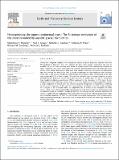Files in this item
Homogenising the upper continental crust : the Si isotope evolution of the crust recorded by ancient glacial diamictites
Item metadata
| dc.contributor.author | Murphy, Madeleine | |
| dc.contributor.author | Savage, Paul S. | |
| dc.contributor.author | Gardiner, Nicholas J. | |
| dc.contributor.author | Prave, Tony | |
| dc.contributor.author | Gaschnig, Richard | |
| dc.contributor.author | Rudnick, Roberta | |
| dc.date.accessioned | 2022-05-30T13:30:17Z | |
| dc.date.available | 2022-05-30T13:30:17Z | |
| dc.date.issued | 2022-08-01 | |
| dc.identifier | 279646435 | |
| dc.identifier | e6232196-f802-4ca9-86da-130392bce0c8 | |
| dc.identifier | 85131461168 | |
| dc.identifier | 000812307000009 | |
| dc.identifier.citation | Murphy , M , Savage , P S , Gardiner , N J , Prave , T , Gaschnig , R & Rudnick , R 2022 , ' Homogenising the upper continental crust : the Si isotope evolution of the crust recorded by ancient glacial diamictites ' , Earth and Planetary Science Letters , vol. 591 , 117620 . https://doi.org/10.1016/j.epsl.2022.117620 | en |
| dc.identifier.issn | 0012-821X | |
| dc.identifier.other | ORCID: /0000-0002-4614-3774/work/114023251 | |
| dc.identifier.other | ORCID: /0000-0003-3465-9295/work/114023307 | |
| dc.identifier.other | ORCID: /0000-0001-8464-0264/work/114023322 | |
| dc.identifier.uri | https://hdl.handle.net/10023/25466 | |
| dc.description | This work was supported by PhD funding to MM by the University of St Andrews School of Earth and Environmental Sciences and the Handsel scheme, as well as by NERC grant NE/R002134/1 to PS and NSF grant EAR-1321954 to RR and RG. | en |
| dc.description.abstract | Twenty-four composite samples of the fine-grained matrix of glacial diamictites deposited from the Mesoarchaean to Palaeozoic have been analysed for their silicon isotope composition and used to establish, for the first time, the long-term secular Si isotope record of the compositional evolution of upper continental crust (UCC). Diamictites with Archaean and Palaeoproterozoic Nd model ages show greater silicon isotope heterogeneity than those with younger model ages (irrespective of depositional age). We attribute the anomalously light Si isotope compositions of some diamictites with Archaean model ages to the presence of glacially milled banded iron formation (BIF), substantiated by the high iron content and Ge/Si in these samples. We infer that relatively heavy Si isotope signatures in some Palaeoproterozoic diamictites (all of which have Archaean Nd model ages) are due to contribution from tonalite-trondhjemite-granodiorites (TTGs), evidenced by the abundance of TTG clasts. By the Neoproterozoic (with model ages ranging from 2.3 to 1.8 Ga), diamictite Si isotope compositions exhibit a range comparable to modern UCC. This reduced variability through time is interpreted as reflecting the decreasing importance of BIF and TTG in post-Archaean continental crust. The secular evolution of Si isotopes in the diamictites offers an independent test of models for the emergence of stable cratons and the onset of horizontal mobile-lid tectonism. The early Archaean UCC was heterogeneous and incorporated significant amounts of isotopically light BIF, but following the late Archaean stabilisation of cratons, coupled with the oxygenation of the atmosphere that led to the reduced neoformation of BIF and diminishing quantities of TTGs, the UCC became increasingly homogeneous. This homogenisation likely occurred via reworking of preexisting crust, as evidenced by Archaean Nd model ages recorded in younger diamictites. | |
| dc.format.extent | 1939745 | |
| dc.language.iso | eng | |
| dc.relation.ispartof | Earth and Planetary Science Letters | en |
| dc.subject | Silicon isotopes | en |
| dc.subject | Upper continental crust | en |
| dc.subject | Glacial diamictites | en |
| dc.subject | Crustal reworking | en |
| dc.subject | Secular change | en |
| dc.subject | GE Environmental Sciences | en |
| dc.subject | NDAS | en |
| dc.subject.lcc | GE | en |
| dc.title | Homogenising the upper continental crust : the Si isotope evolution of the crust recorded by ancient glacial diamictites | en |
| dc.type | Journal article | en |
| dc.contributor.sponsor | NERC | en |
| dc.contributor.institution | University of St Andrews. School of Earth & Environmental Sciences | en |
| dc.contributor.institution | University of St Andrews. St Andrews Centre for Exoplanet Science | en |
| dc.contributor.institution | University of St Andrews. St Andrews Isotope Geochemistry | en |
| dc.contributor.institution | University of St Andrews. Marine Alliance for Science & Technology Scotland | en |
| dc.contributor.institution | University of St Andrews. Scottish Oceans Institute | en |
| dc.contributor.institution | University of St Andrews. St Andrews Sustainability Institute | en |
| dc.identifier.doi | 10.1016/j.epsl.2022.117620 | |
| dc.description.status | Peer reviewed | en |
| dc.identifier.grantnumber | NSF | en |
This item appears in the following Collection(s)
Items in the St Andrews Research Repository are protected by copyright, with all rights reserved, unless otherwise indicated.

